Returning an Iconic Species to London
Digby Wheeler is Urban Rewilding Officer for Citizen Zoo, a London-based community interest company dedicated to rewilding around the country. Their work empowers volunteers to make a positive difference and restore nature and help both species and habitats thrive. Digby formerly worked as a Data Assistant for GiGL, where he was responsible for updating, maintaining and improving London’s species dataset, and gained a deeper understanding of greater London’s species diversity and distribution. GiGL have historically partnered with Citizen Zoo to provide habitat suitability mapping for successful water vole reintroductions in Kingston-upon-Thames and both teams will be working together on the recently-announced White Storks in London Project.
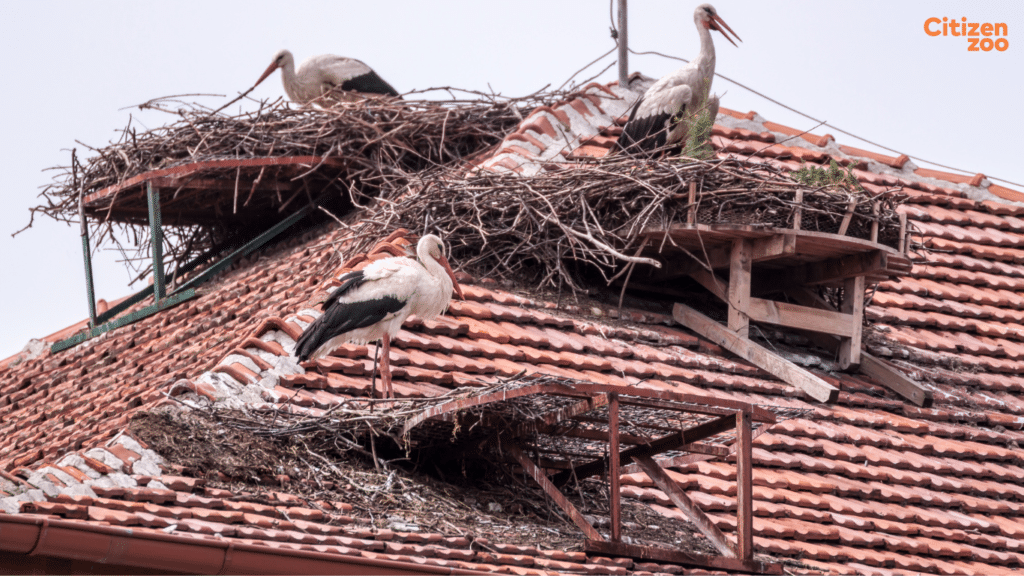
At Citizen Zoo, we are very excited to announce we are exploring the potential return of majestic white storks to London. We are also delighted to feature in this month’s GiGLer with an article that will dive into the history and ecology of these iconic birds, outline the aims of our collaborative project to one day restore the species to the capital, showcase our partnership with GiGL, who will provide vital mapping and data services to optimise the success of the scheme, and share ways in which conservation organisations and the public can get involved.
White Storks in Europe and Britain: A Brief History
White storks (Ciconia ciconia) are an unmistakable and inspiring species that have symbolised hope, regrowth and new life for millennia. Across their migratory range in Europe, their yearly return from overwintering in Africa is heralded as the start of spring.
Fascinatingly, white storks even revolutionised our understanding of bird distribution and migratory behaviour. The famous Rostocker Pfeilstorch (“arrow stork”), sighted in Germany in 1822 – still alive despite being impaled through the neck by a hunting spear – provided some of the earliest evidence for cross-continental migration, a phenomenon that had perplexed natural historians for centuries.
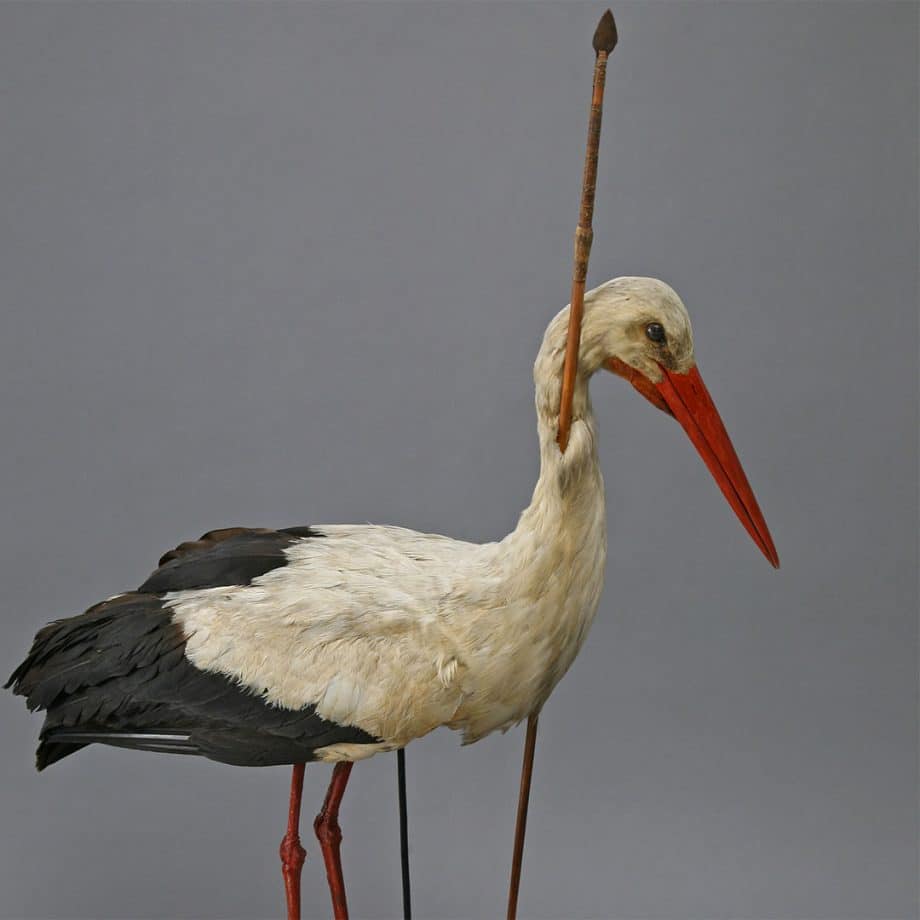
While native to the UK, white storks have been absent for centuries, following their decline and eventual extinction in the 15th century due to overhunting, loss of habitat and suitable nesting sites, and changing agricultural practices.
Despite their elimination from the UK, their cultural impact is reflected in place names such as Storrington in West Sussex and through numerous historical references such as the famous breeding pair spotted nesting atop St. Giles’ Cathedral in Edinburgh in 1416. The species also still persists in the popular imagination (see Aesop’s fables to Dumbo), with 86% of participants (n=3531) in a 2023 study on British public perceptions in support of potential reintroductions.
White Storks in London
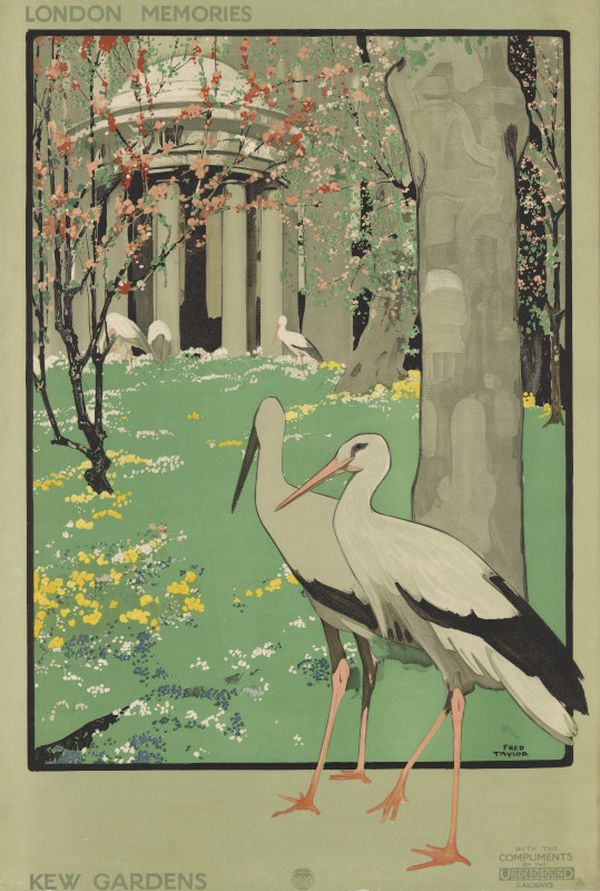
Since 2016, the White Stork Project in Sussex has demonstrated the possibility of establishing breeding white storks in the UK. Following the growing success of this initiative, Citizen Zoo are now pressing ahead with our vision of one day returning breeding storks to the capital.
Within London, it is possible to identify a historical fascination with the birds. From the 1918 Underground poster showcasing the captive storks at Kew Gardens to the more recent inclusion of a pair at the WWT’s London Wetland Centre in Barnes. Furthermore, with natural migratory overshoots of individuals into the British Isles, it hasn’t been entirely uncommon to spot stork flyovers and stop-offs in Greater London boroughs and surrounding counties. With the Sussex project reporting increasing numbers of successful fledglings year-on-year, sightings of storks in and over London seem to be increasing as more birds explore and become established in nearby areas of the South East.
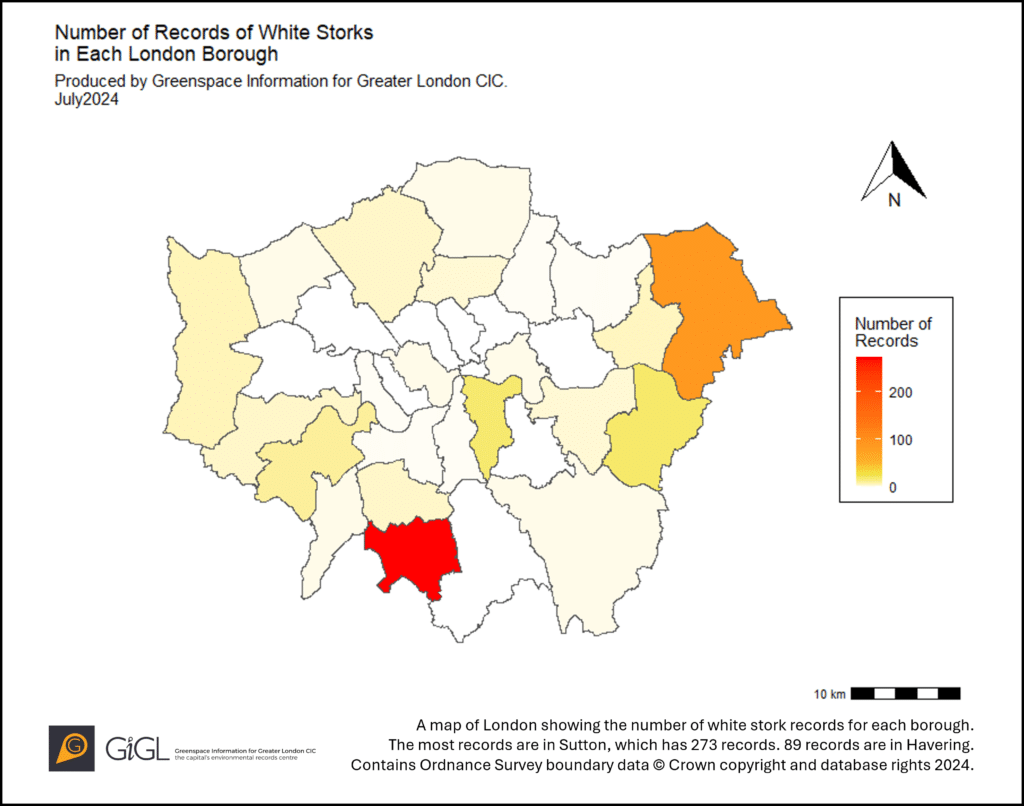
Above: Heat map produced by Greenspace Information for Greater London CIC showing white stork records for the London Boroughs. Right:
A table showing the number of records per year.
Please note that species counts are dependent on recording effort. London Natural History Society bird records from 2022 – 2023 are yet to be added to the GiGL database.
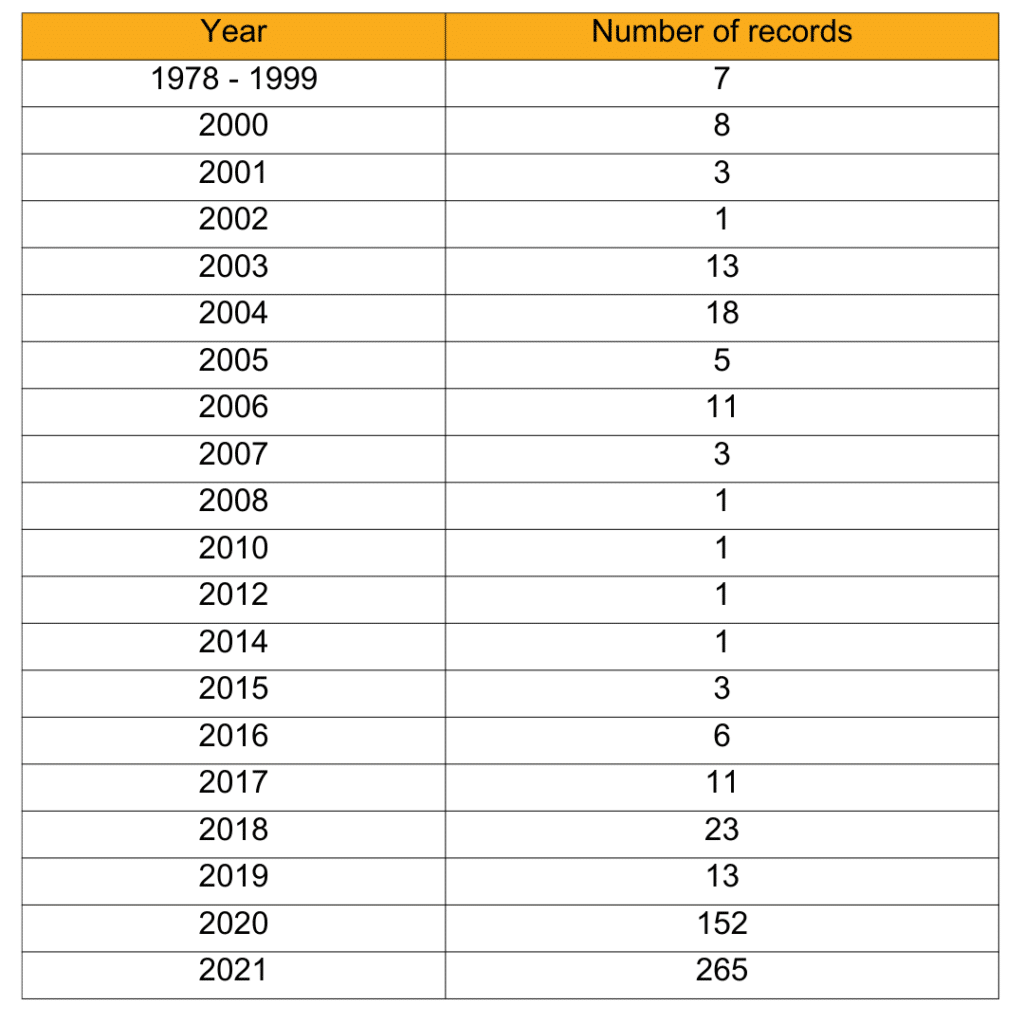
White Stork ecology and habitat
Any efforts to return white storks to their former range requires thorough knowledge of their ecology. Storks prefer open wetlands, pastures, and farmlands. They can tolerate and thrive near human settlements, and breed successfully in many inhabited regions of Europe, from Alsace to the Algarve, in parts of Germany, and with strongholds in Spain, Poland and the Baltic nations (see the European Stork Villages Network here).
They feed on a wide variety of prey, including insects, fish, amphibians, reptiles, small mammals, and small birds. Ecologically, they help control populations of these prey species and facilitate nutrient cycling through their feeding activities. Additionally, stork nests – which can grow up to several metres across and weigh over a tonne – provide habitat for a variety of other species, such as birds, mammals and a wide array of invertebrates.
Although ecologically important in their own right, storks are also considered an ‘umbrella species’, i.e. a single, charismatic species whose protection can have a wide range of benefits for other species and habitats. In this case, the large areas of wetlands and open fields vital for storks’ survival will inevitably support a diverse range of other species. We seek to promote discussion of the white stork’s return as a catalyst for habitat restoration across London and engage the public in the topic of ecological recovery for the capital’s land, water and skies.
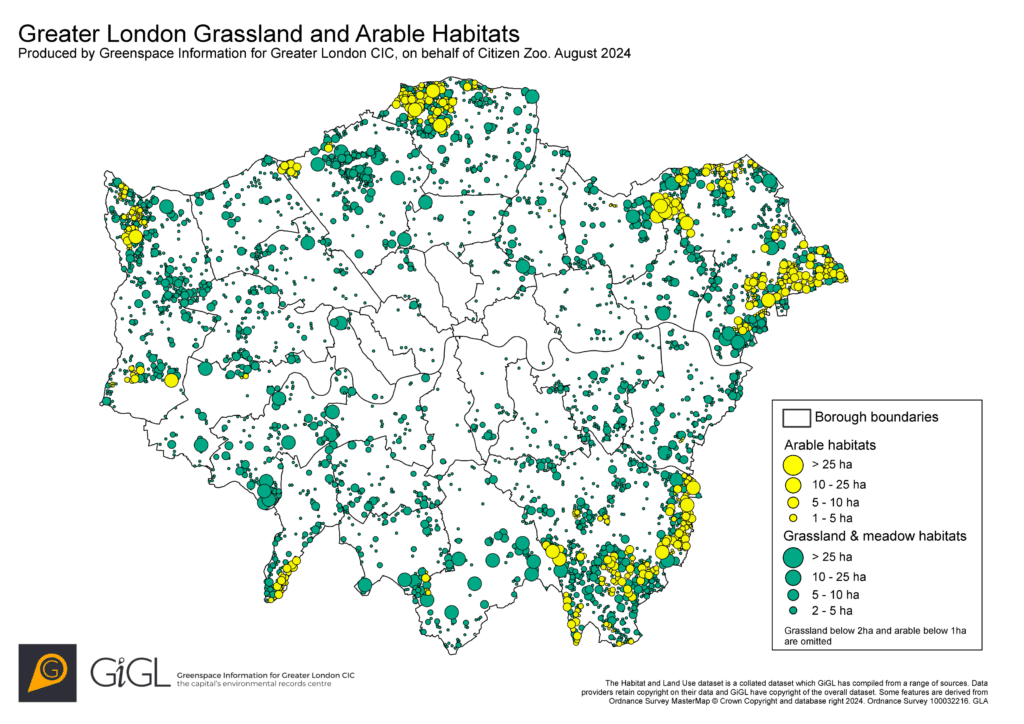
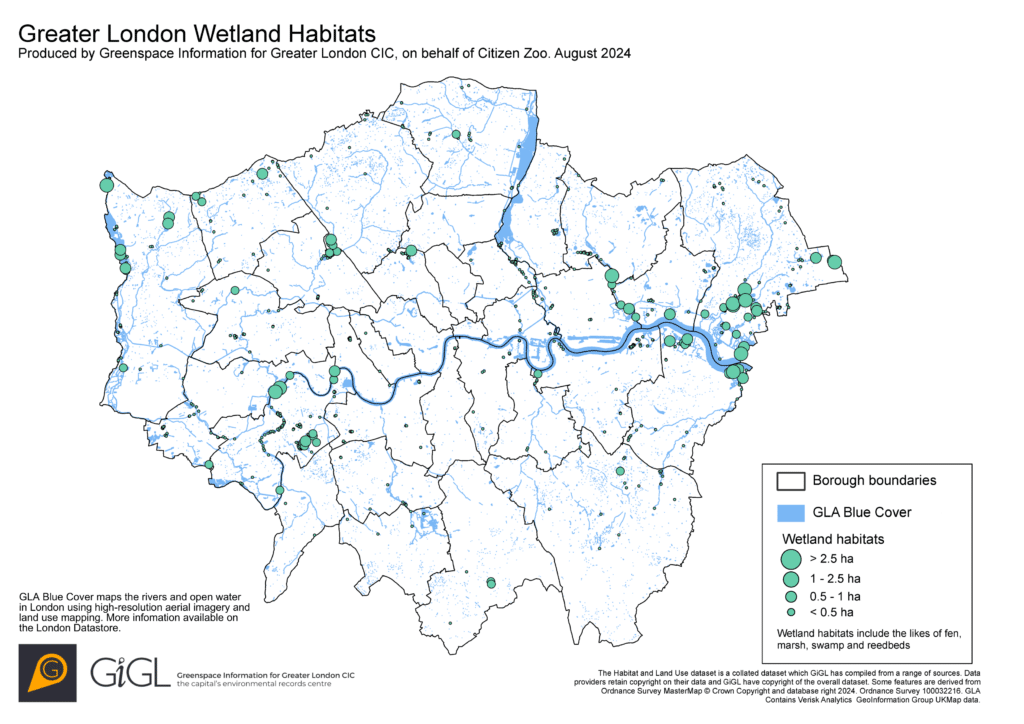
Overall project aims
Citizen Zoo believes that white storks have the potential to thrive in London as they do in many urban landscapes across Europe and they could become a symbol for nature recovery within a wilder, more resilient and biodiverse capital, where people are able to interact and engage with nature on a daily basis.
However, we also recognise that much will need to be done to enable white storks to thrive within our city, we wish to start the discussion and explore this topic further across six key focus areas to identify what actions need to be taken to help make this dream a reality.
1. Habitat assessment across London:
In collaboration with GiGL, we will examine habitat data across London to identify areas capable of supporting white stork populations. Through this assessment, we aim to create a comprehensive map highlighting white stork habitat hotspots, while also evaluating landscape connectivity.
2. Understanding the political landscape:
Evaluating the political will for coexisting with white storks, we will reach out to the Mayor of London and the 33 local authorities to gauge their receptiveness towards hosting white stork populations within their respective boroughs. This data will provide insights into political acceptance and will be mapped by boroughs, improving our understanding of where white storks would be accepted politically.
3. Engaging with communities to raise awareness of the project & gathering people’s views:
Throughout the year we will be engaging with communities through a series of physical and virtual events, we will raise awareness about the significance of white storks and encourage feedback on the concept through community consultations.
4. Establishing a ‘London White Stork Working Group’:
We will establish a London White Stork Working Group, convening relevant stakeholders including the London Wildlife Trust, interested local authorities, conservation organisations, and representatives from Natural England and the Environment Agency. Through inclusive and informative meetings, we aim to foster collaboration and discussion on the matter, drawing inspiration from the successful model of the London Beaver Working Group.
5. Identifying opportunities of habitat enhancement and restoration:
With the support of habitat mapping we will investigate and identify habitat restoration opportunities across London, we will seek to enhance habitats conducive to white stork habitation, thereby facilitating their successful establishment and breeding.
6. Conducting an options appraisal to promote white stork recovery in London:
We will undertake a comprehensive options appraisal, which will explore various strategies to encourage the establishment of viable white stork populations. This includes assessing the feasibility of promoting natural recolonisation events and possible proactive methods, aiming to create an informed plan on how we can promote white stork conservation within London.
Want to get involved?
The London White Stork Working Group will be an inclusive platform for organisations and individuals to facilitate discussion on white storks within the London context. The inaugural call for the group will take place this autumn (date TBC) and will feature a presentation from a leading voice in UK white stork reintroductions.
If you would like to join the meeting and find out more please email digby@citizenzoo.org. Additionally, if you know of any sites in London that could be suitable for their reintroduction, we would love to hear from you.
Last, but certainly not least, if you spot white storks in London or possess historical records that have not yet been shared, please feel free to submit your sighting to GiGL via the new White Stork Recording Form.

great stuff will be the need of suitable habitat and sufficient prey on continent seen them prowling about in uncultivated pasture do we have enough here ?